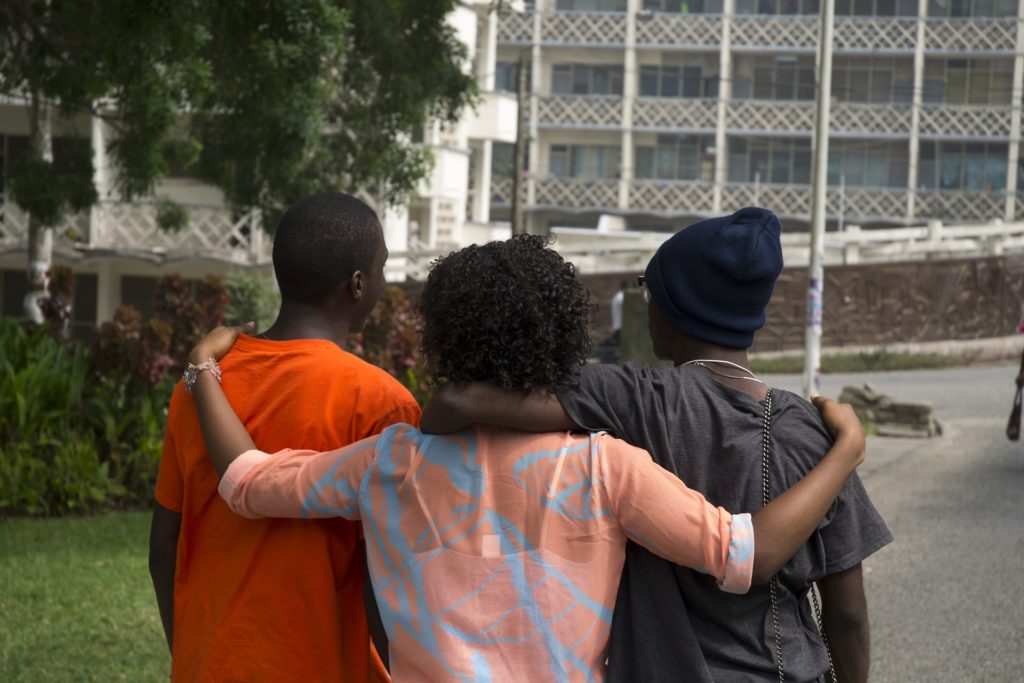
Adolescence is a period of personal and social identity formation, in which different roles, behaviors, and ideologies are explored. In the United States, adolescence is seen as a time to develop independence from parents while remaining connected to them. Some key points related to social development during adolescence include the following:
- Adolescence is the period of life known for the formation of personal and social identity.
- Adolescents must explore, test limits, become autonomous, and commit to an identity, or sense of self.
- Erik Erikson referred to the task of the adolescent as one of identity versus role confusion. Thus, in Erikson’s view, an adolescent’s main questions are “Who am I?” and “Who do I want to be?”
- Early in adolescence, cognitive developments result in greater self-awareness, the ability to think about abstract, future possibilities, and the ability to consider multiple possibilities and identities at once.
- Changes in the levels of certain neurotransmitters (such as dopamine and serotonin) influence how adolescents experience emotions, typically making them more emotional and more sensitive to stress.
- When adolescents have advanced cognitive development and maturity, they tend to resolve identity issues more easily than peers who are less cognitively developed.
- As adolescents work to form their identities, they pull away from their parents, and the peer group becomes very important; despite this, relationships with parents still play a significant role in identity formation.
Identity Formation
Psychosocial Development
Identity Development

Identity development is a stage in the adolescent life cycle. For most, the search for identity begins in the adolescent years. During these years, adolescents are more open to ‘trying on’ different behaviors and appearances to discover who they are. In an attempt to find their identity and discover who they are, adolescents are likely to cycle through several identities to find one that suits them best. Developing and maintaining identity (in adolescent years) is a difficult task due to multiple factors such as family life, environment, and social status. Empirical studies suggest that this process might be more accurately described as identity development, rather than formation, but confirms a normative process of change in both content and structure of one’s thoughts about the self.
Self-Concept
Two main aspects of identity development are self-concept and self-esteem. The idea of self-concept is known as the ability of a person to have opinions and beliefs that are defined confidently, consistently, and with stability. Early in adolescence, cognitive developments result in greater self-awareness, greater awareness of others and their thoughts and judgments, the ability to think about abstract, future possibilities, and the ability to consider multiple possibilities at once. As a result, adolescents experience a significant shift from the simple, concrete, and global self-descriptions typical of young children; as children, they defined themselves by physical traits whereas adolescents define themselves based on their values, thoughts, and opinions.
Adolescents can conceptualize multiple “possible selves” that they could become and long-term possibilities and consequences of their choices. Exploring these possibilities may result in abrupt changes in self-presentation as the adolescent chooses or rejects qualities and behaviors, trying to guide the actual self toward the ideal self (who the adolescent wishes to be) and away from the feared self (who the adolescent does not want to be). For many, these distinctions are uncomfortable, but they also appear to motivate achievement through behavior consistent with the ideal and distinct from the feared possible selves.
Further distinctions in self-concept, called “differentiation,” occur as the adolescent recognizes the contextual influences on their own behavior and the perceptions of others, and begin to qualify their traits when asked to describe themselves. Differentiation appears fully developed by mid-adolescence. Peaking in the 7th-9th grades, the personality traits adolescents use to describe themselves refer to specific contexts, and therefore may contradict one another. The recognition of inconsistent content in the self-concept is a common source of distress in these years, but this distress may benefit adolescents by encouraging structural development.
Self-Esteem
Another aspect of identity formation is self-esteem. Self-esteem is defined as one’s thoughts and feelings about one’s self-concept and identity. Most theories on self-esteem state that there is a grand desire, across all genders and ages, to maintain, protect and enhance their self-esteem. Contrary to popular belief, there is no empirical evidence for a significant drop in self-esteem over the course of adolescence. “Barometric self-esteem” fluctuates rapidly and can cause severe distress and anxiety, but baseline self-esteem remains highly stable across adolescence. The validity of global self-esteem scales has been questioned, and many suggest that more specific scales might reveal more about the adolescent experience. Girls are most likely to enjoy high self-esteem when engaged in supportive relationships with friends, the most important function of friendship to them is having someone who can provide social and moral support. When they fail to win friends’ approval or can’t find someone with whom to share common activities and common interests, in these cases, girls suffer from low self-esteem.
In contrast, boys are more concerned with establishing and asserting their independence and defining their relation to authority. As such, they are more likely to derive high self-esteem from their ability to successfully influence their friends; on the other hand, the lack of romantic competence, for example, failure to win or maintain the affection of the opposite or same-sex (depending on sexual orientation), is the major contributor to low self-esteem in adolescent boys.
Identity Formation: Who am I?
Adolescents continue to refine their sense of self as they relate to others. Erik Erikson referred to life’s fifth psychosocial task as one of identity versus role confusion when adolescents must work through the complexities of finding one’s own identity. Individuals are influenced by how they resolved all of the previous childhood psychosocial crises and this adolescent stage is a bridge between the past and the future, between childhood and adulthood. Thus, in Erikson’s view, an adolescent’s main questions are “Who am I?” and “Who do I want to be?” Identity formation was highlighted as the primary indicator of successful development during adolescence (in contrast to role confusion, which would be an indicator of not successfully meeting the task of adolescence). This crisis is resolved positively with identity achievement and the gain of fidelity (ability to be faithful) as a new virtue when adolescents have reconsidered the goals and values of their parents and culture. Some adolescents adopt the values and roles that their parents expect for them. Other teens develop identities that are in opposition to their parents but align with a peer group. This is common as peer relationships become a central focus in adolescents’ lives.
Expanding on Erikson’s theory, Marcia (1966) described identity formation during adolescence as involving both decision points and commitments with respect to ideologies (e.g., religion, politics) and occupations. Foreclosure occurs when an individual commits to an identity without exploring options. Identity confusion/diffusion occurs when adolescents neither explore nor commit to any identities. Moratorium is a state in which adolescents are actively exploring options but have not yet made commitments. As mentioned earlier, individuals who have explored different options, discovered their purpose, and have made identity commitments are in a state of identity achievement.
Developmental psychologists have researched several different areas of identity development and some of the main areas include:
- Religious identity: The religious views of teens are often similar to those of their families (Kim-Spoon, Longo, & McCullough, 2012) Most teens may question specific customs, practices, or ideas in the faith of their parents, but few completely reject the religion of their families.
- Political identity: An adolescent’s political identity is also influenced by their parents’ political beliefs. A new trend in the 21st century is a decrease in party affiliation among adults. Many adults do not align themselves with either the democratic or republican party and their teenage children reflect their parents’ lack of party affiliation. Although adolescents do tend to be more liberal than their elders, especially on social issues (Taylor, 2014), like other aspects of identity formation, adolescents’ interest in politics is predicted by their parents’ involvement and by current events (Stattin et al., 2017).
- Vocational identity: While adolescents in earlier generations envisioned themselves as working in a particular job, and often worked as an apprentice or part-time in such occupations as teenagers, this is rarely the case today. Vocational identity takes longer to develop, as most of today’s occupations require specific skills and knowledge that will require additional education or are acquired on the job itself. In addition, many of the jobs held by teens are not in occupations that most teens will seek as adults.

Figure 2. This identity spectrum shows the fluidity between sex, gender identity, gender expression, and sexual orientation.
- Ethnic identity: Ethnic identity refers to how people come to terms with who they are based on their ethnic or racial ancestry. According to the U.S. Census (2012), more than 40% of Americans under the age of 18 are from ethnic minorities. For many ethnic minority teens, discovering one’s ethnic identity is an important part of identity formation. Phinney (1989)proposed a model of ethnic identity development that included stages of unexplored ethnic identity, ethnic identity search, and achieved ethnic identity.
- Gender identity: A person’s sex, as determined by his or her biology, does not always correspond with his or her gender. Sex refers to the biological differences between males and females, such as genitalia and genetic differences. Gender refers to the socially constructed characteristics of women and men, such as norms, roles, and relationships between groups of women and men. Many adolescents use their analytic, hypothetical thinking to question traditional gender roles and expression. If their genetically assigned sex does not line up with their gender identity, they may refer to themselves as transgender, non-binary, or gender-nonconforming.
- Gender identity refers to a person’s self-perception as male, female, both, genderqueer, or neither. Cisgender is an umbrella term used to describe people whose sense of personal identity and gender corresponds with their birth sex, while transgender is a term used to describe people whose sense of personal identity does not correspond with their birth sex. Gender expression, or how one demonstrates gender (based on traditional gender role norms related to clothing, behavior, and interactions) can be feminine, masculine, androgynous, or somewhere along a spectrum.
- Fluidity and uncertainty regarding sex and gender are especially common during early adolescence when hormones increase and fluctuate creating a difficulty of self-acceptance and identity achievement (Reisner et al., 2016). Gender identity, like vocational identity, is becoming an increasingly prolonged task as attitudes and norms regarding gender keep changing. The roles appropriate for males and females are evolving and some adolescents may foreclose on gender identity as a way of dealing with this uncertainty by adopting more stereotypic male or female roles (Sinclair & Carlsson, 2013). Those that identify as transgender or other face even bigger challenges.
Social Development during Adolescence
Parents
It appears that most teens do not experience adolescent “storm and stress“ to the degree once famously suggested by G. Stanley Hall, a pioneer in the study of adolescent development. Only small numbers of teens have major conflicts with their parents (Steinberg & Morris, 2001), and most disagreements are minor. For example, in a study of over 1,800 parents of adolescents from various cultural and ethnic groups, Barber (1994) found that conflicts occurred over day-to-day issues such as homework, money, curfews, clothing, chores, and friends. These disputes occur because an adolescent’s drive for independence and autonomy conflicts with the parent’s supervision and control. These types of arguments tend to decrease as teens develop (Galambos & Almeida, 1992).
As adolescents work to form their identities, they pull away from their parents, and the peer group becomes very important (Shanahan, McHale, Osgood, & Crouter, 2007). Despite spending less time with their parents, most teens report positive feelings toward them (Moore, Guzman, Hair, Lippman, & Garrett, 2004). Warm and healthy parent-child relationships have been associated with positive child outcomes, such as better grades and fewer school behavior problems, in the United States as well as in other countries (Hair et al., 2005).
Although peers take on greater importance during adolescence, family relationships remain important too. One of the key changes during adolescence involves a renegotiation of parent-child relationships. As adolescents strive for more independence and autonomy during this time, different aspects of parenting become more salient. For example, parents’ distal supervision and monitoring become more important as adolescents spend more time away from parents and in the presence of peers. Parental monitoring encompasses a wide range of behaviors such as parents’ attempts to set rules and know their adolescents’ friends, activities, and whereabouts, in addition to adolescents’ willingness to disclose information to their parents. (Stattin & Kerr, 2000) Psychological control, which involves manipulation and intrusion into adolescents’ emotional and cognitive world through invalidating adolescents’ feelings and pressuring them to think in particular ways is another aspect of parenting that becomes more salient during adolescence and is related to more problematic adolescent adjustment.
Peers

As children become adolescents, they usually begin spending more time with their peers and less time with their families, and these peer interactions are increasingly unsupervised by adults. Children’s notions of friendship often focus on shared activities, whereas adolescents’ notions of friendship increasingly focus on intimate exchanges of thoughts and feelings.
Crowds are an emerging level of peer relationships in adolescence. In contrast to friendships (which are reciprocal dyadic relationships) and cliques (which refer to groups of individuals who interact frequently), crowds are characterized more by shared reputations or images than actual interactions (Brown & Larson, 2009) These crowds reflect different prototypic identities (such as jocks or brains) and are often linked with adolescents’ social status and peers’ perceptions of their values or behaviors.
Romantic relationships
Adolescence is the developmental period during which romantic relationships typically first emerge. Initially, same-sex peer groups that were common during childhood expand into mixed-sex peer groups that are more characteristic of adolescence. Romantic relationships often form in the context of these mixed-sex peer groups (Connolly, Furman, & Konarski, 2000) Although romantic relationships during adolescence are often short-lived rather than long-term committed partnerships, their importance should not be minimized. Adolescents spend a great deal of time focused on romantic relationships, and their positive and negative emotions are more tied to romantic relationships (or lack thereof) than to friendships, family relationships, or school (Furman & Shaffer, 2003) Romantic relationships contribute to adolescents’ identity formation, changes in family and peer relationships, and adolescents’ emotional and behavioral adjustment.
Furthermore, romantic relationships are centrally connected to adolescents’ emerging sexuality. Parents, policymakers, and researchers have devoted a great deal of attention to adolescents’ sexuality, in large part because of concerns related to sexual intercourse, contraception, and preventing teen pregnancies. However, sexuality involves more than this narrow focus. Sexual orientation refers to whether a person is sexually and romantically attracted to others of the same sex, the opposite sex, or both sexes. For example, adolescence is often when individuals who are lesbian, gay, bisexual, or transgender come to perceive themselves as such (Russell, Clarke, & Clary, 2009) Thus, romantic relationships are a domain in which adolescents experiment with new behaviors and identities.
Many adolescents may choose to come out during this period of their life once an identity has been formed; many others may go through a period of questioning or denial, which can include experimentation with both homosexual and heterosexual experiences. A study of 194 lesbian, gay, and bisexual youths under the age of 21 found that having an awareness of one’s sexual orientation occurred, on average, around age 10, but the process of coming out to peers and adults occurred around age 16 and 17, respectively. Coming to terms with and creating a positive LGBT identity can be difficult for some youth for a variety of reasons. Peer pressure is a large factor when youth who are questioning their sexuality or gender identity are surrounded by heteronormative peers and can cause great distress due to a feeling of being different from everyone else. While coming out can also foster better psychological adjustment, the risks associated are real. Indeed, coming out in the midst of a heteronormative peer environment often comes with the risk of ostracism, hurtful jokes, and even violence. Because of this, statistically, the suicide rate amongst LGBT adolescents is up to four times higher than that of their heterosexual peers due to bullying and rejection from peers or family members.
Diversity
Adolescent development does not necessarily follow the same pathway for all individuals. Certain features of adolescence, particularly with respect to biological changes associated with puberty and cognitive changes associated with brain development, are relatively universal. But other features of adolescence depend largely on circumstances that are more environmentally variable. For example, adolescents growing up in one country might have different opportunities for risk-taking than adolescents in another country, and supports and sanctions for different behaviors in adolescence depend on laws and values that might be specific to where adolescents live. Likewise, different cultural norms regarding family and peer relationships shape adolescents’ experiences in these domains. For example, in some countries, adolescents’ parents are expected to retain control over major decisions, whereas, in other countries, adolescents are expected to begin sharing in or taking control of decision-making.
Even within the same country, adolescents’ gender, ethnicity, immigrant status, religion, sexual orientation, socioeconomic status, and personality can shape both how adolescents behave and how others respond to them, creating diverse developmental contexts for different adolescents. For example, early puberty (that occurs before most other peers have experienced puberty) appears to be associated with worse outcomes for girls than boys, likely in part because girls who enter puberty early tend to associate with older boys, which in turn is associated with early sexual behavior and substance use. For adolescents who are ethnic or sexual minorities, discrimination sometimes presents a set of challenges that non-minorities do not face.
Finally, genetic variations contribute an additional source of diversity in adolescence. Current approaches emphasize gene X environment interactions, which often follow a differential susceptibility model (Belsky & Pluess, 2009) That is, particular genetic variations are considered riskier than others, but genetic variations also can make adolescents more or less susceptible to environmental factors. For example, the association between the CHRM2 genotype and adolescent externalizing behavior (aggression and delinquency) has been found in adolescents whose parents are low in monitoring behaviors (Dick et al., 2011) Thus, it is important to bear in mind that individual differences play an important role in adolescent development.
Behavioral and Psychological Adjustment
Aggression and Antisocial Behavior

Several major theories of the development of antisocial behavior treat adolescence as an important period. Patterson’s (1982) early versus late starter model of the development of aggressive and antisocial behavior distinguishes youths whose antisocial behavior begins during childhood (early starters) versus adolescence (late starters). According to the theory, early starters are at greater risk for long-term antisocial behavior that extends into adulthood than are late starters. Late starters who become antisocial during adolescence are theorized to experience poor parental monitoring and supervision, aspects of parenting that become more salient during adolescence. Poor monitoring and lack of supervision contribute to increasing involvement with deviant peers, which in turn promotes adolescents’ own antisocial behavior. Late starters desist from antisocial behavior when changes in the environment make other options more appealing.
Similarly, Moffitt’s (1993) life-course persistent versus adolescent-limited model distinguishes between antisocial behavior that begins in childhood versus adolescence. Moffitt regards adolescent-limited antisocial behavior as resulting from a “maturity gap” between adolescents’ dependence on and control by adults and their desire to demonstrate their freedom from adult constraint. However, as they continue to develop, and legitimate adult roles and privileges become available to them, there are fewer incentives to engage in antisocial behavior, leading to resistance in these antisocial behaviors.
Anxiety and Depression
Developmental models of anxiety and depression also treat adolescence as an important period, especially in terms of the emergence of gender differences in prevalence rates that persist through adulthood (Rudolph, 2009) Starting in early adolescence, compared with males, females have rates of anxiety that are about twice as high and rates of depression that are 1.5 to 3 times as high (American Psychiatric Association, 2013) Although the rates vary across specific anxiety and depression diagnoses, rates for some disorders are markedly higher in adolescence than in childhood or adulthood. For example, prevalence rates for specific phobias are about 5% in children and 3%–5% in adults but 16% in adolescents. Additionally, some adolescents sink into major depression, deep sadness, and hopelessness that disrupt all normal, regular activities. Causes include many factors such as genetics and early childhood experiences that predate adolescence, but puberty may push vulnerable children, especially girls into despair.
During puberty, the rate of major depression more than doubles to an estimated 15%, affecting about one in five girls and one in ten boys. Gender difference occurs for many reasons, biological and cultural (Uddin et al., 2010) Anxiety and depression are particularly concerning because suicide is one of the leading causes of death during adolescence. Some adolescents experience suicidal ideation (distressing thoughts about killing oneself) which become most common at about age 15 (Berger, 2019) and can lead to parasuicide, also called attempted suicide or failed suicide. Suicidal ideation and parasuicide should be taken seriously and serve as a warning that emotions may be overwhelming.
Developmental models focus on interpersonal contexts in both childhood and adolescence that foster depression and anxiety (e.g., Rudolph, 2009) Family adversity, such as abuse and parental psychopathology, during childhood sets the stage for social and behavioral problems during adolescence. Adolescents with such problems generate stress in their relationships (e.g., by resolving conflict poorly and excessively seeking reassurance) and select into more maladaptive social contexts (e.g., “misery loves company” scenarios in which depressed youths select other depressed youths as friends and then frequently co-ruminate as they discuss their problems, exacerbating negative affect and stress). These processes are intensified for girls compared with boys because girls have more relationship-oriented goals related to intimacy and social approval, leaving them more vulnerable to disruption in these relationships. Anxiety and depression then exacerbate problems in social relationships, which in turn contribute to the stability of anxiety and depression over time.